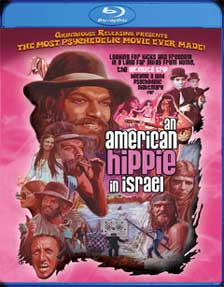 AN
AMERICAN HIPPIE IN ISRAEL (1972) Blu-ray/DVD combo
AN
AMERICAN HIPPIE IN ISRAEL (1972) Blu-ray/DVD comboDirector: Amos Sefer
Grindhouse Releasing
 AN
AMERICAN HIPPIE IN ISRAEL (1972) Blu-ray/DVD combo
AN
AMERICAN HIPPIE IN ISRAEL (1972) Blu-ray/DVD comboBurnt-out Vietnam vet Mike (Asher Tzarfati, DOUBLE TEAM) has embraced the hippie lifestyle and has been bumming around the world trying to escape himself; but his attempts at total freedom are hindered by the persecuting presences of a pair of “creeps” (presumably representing “The Establishment”, at least in the theatrical cut). Immediately after stepping off the plane, Mike takes to hitching a ride and is picked up by dilettante actress Elizabeth (Lily Avidan) who immediately embraces Mike’s philosophy (amongst other things). Cut to: romping through Tel-Aviv montage as they bewilder onlookers with unconventional behavior that tells you they’re free spirits. They quickly hook up with another couple – Pomo (Shmuel Wolf, WAR AND LOVE) and Francoise (Tzila Karney) – and lead an ever-growing Pied Piper-like procession of hippies down the beach to an abandoned warehouse for a love-in. Mike proclaims his desire to find an isolated place for himself and others like him away from the strangling influences of society where they can do their own thing. Just as it seems the film is going to take a Manson-esque turn, the creeps show up again and machine gun the hippies to death. Miraculously, Mike, Elizabeth, Pomo, and Francoise survive and are even more determined to find freedom. They take to the road in Elizabeth’s convertible and paddle across placid waters (pet lamb in tow) to a barren yet seemingly idyllic island off the tip of Eilat. Things start out fine until the tide washes the raft away from the shore and a pair of sharks prevents Mike from swimming back to the mainland; and soon the creeps may be the least of their worries when hunger and a territory war set in.
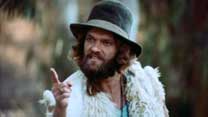
Although the film’s current “Grindhouse-y” moniker was the idea of US distributor Georgie Jessel (who makes a vintage appearance unrelated to the film on a disc Easter Egg), the film – originally titled THE HITCHHIKER – is bizarre enough on its own terms (ideally, I’d screen it in a triple bill with Tonino Cervi’s QUEENS OF EVIL and Niko Mastorakis’ ISLAND OF DEATH which was where I at times thought Sefer’s film might be heading). Despite the ample nudity, drug use, and anti-war sentiment, the film does ultimately seem like a conservative effort wallowing in prurience (although not quite so graphically), with the oppressive forces ambiguously represented in the theatrical cut (and even more so disconnected in the director’s cut). Israel’s hippie population is characterized as long-haired types sitting around idly waiting for a messianic figure to lead them, and their quest for freedom and doing their own thing seems to consist entirely of partying and sex rather than establishing their living arrangements or actually proclaiming their beliefs beyond the world being a corrupt place (one of the songs says of children “one day they’ll have to pay for taking time to play”). Quite a few exchanges are played for laughs but the serious ones are just as likely to provoke laughter or at least tittering, particularly the five minute, single-take argument between Mike and Pomo who cannot understand one another because of the language barrier (the disc’s optional Hebrew subtitles include English translation of the Hebrew dialogue so we an understanding of both sides of the conversation denied the characters). The symbolism is comically heavy-handed, from the opening credits imagery of blooming flowers being crushed under an unmanned steam roller, the innocent lamb, the inexpressive creeps (well, once again, at least in the theatrical cut for the latter), as well as Mike's surreal dream sequence in which soldiers shoot each other at close range, families starve, slaves are whipped, and Mike himself takes giant hammer to humanoids with tape recorder heads. Ultimately it may fail to engage the viewer as an actual countercultural work, but it’s still thoroughly engaging as a “grindhouse” film whether you feel the need to shout at the screen for its inanities or just take it in as a product of its time and the state of the industry in its country.
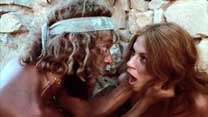 The
film has a certain technical roughness, although the cinematography Jacob Kallach
(ATTACK AT DAWN) is consistently attractive once the film leaves the city for
the desert road trip scenes and the ravishingly beautiful Coral Island (the
natural and manmade structures of which gave ample opportunities for creative
framing). A relatively prolific actor in the early days of Israeli film, Tzarfati
of course crossed paths with producers Menahem Golan and Yoram Globus, appearing
in pre-Cannon efforts like THE URANIUM CONSPIRACY and ATTACK AT DAWN as well
as the later nineties Cannon/Chuck Norris pic (after Golan had parted ways with
Globus) HELLBOUND. The half-folksy/half-psychedelic scoring was the work of
Nachum Heiman who provided more conventional accompaniment the following year
for the morose British horror film NEITHER THE SEA NOR THE SAND. Assistant director
John Stodel served as production manager on many a later Golan-Globus Cannon
production as well as several of Golan’s South Africa-lensed 21st Century
Film Corporation productions from the late eighties and nineties.
The
film has a certain technical roughness, although the cinematography Jacob Kallach
(ATTACK AT DAWN) is consistently attractive once the film leaves the city for
the desert road trip scenes and the ravishingly beautiful Coral Island (the
natural and manmade structures of which gave ample opportunities for creative
framing). A relatively prolific actor in the early days of Israeli film, Tzarfati
of course crossed paths with producers Menahem Golan and Yoram Globus, appearing
in pre-Cannon efforts like THE URANIUM CONSPIRACY and ATTACK AT DAWN as well
as the later nineties Cannon/Chuck Norris pic (after Golan had parted ways with
Globus) HELLBOUND. The half-folksy/half-psychedelic scoring was the work of
Nachum Heiman who provided more conventional accompaniment the following year
for the morose British horror film NEITHER THE SEA NOR THE SAND. Assistant director
John Stodel served as production manager on many a later Golan-Globus Cannon
production as well as several of Golan’s South Africa-lensed 21st Century
Film Corporation productions from the late eighties and nineties.

Grindhouse Releasing’s first Blu-ray release (actually a Blu-ray/DVD combo) features an attractive 1080p24 MPEG-4 AVC-encoded 1.78:1 widescreen transfer of a virtually unblemished source (apart from some rare marks that appear long the left edge of the frame) of the American theatrical cut. Colors are bold and the image must be as sharp as the original cinematography allows. The 1.0 mono track (DTS-HD Master Audio on the Blu-ray and Dolby Digital on the DVD) is clean and vivid when it comes to the music. Optional Hebrew subtitles are also included (and they switch to English whenever Hebrew is spoken, although I’m guessing original theatrical prints did not translate the dialogue). The film can also be viewed with a Dolby Digital 5.1 track labeled “The Beverly Cinema Experience” (not unlike the alternate track featured on Grindhouse’s release of PIECES) which finds the audience for that screening reasonably respectful while understandably amused at the protagonist’s not-quite-authentic usages of American-isms as well as DRAGNET-esque usages of hippie slang. They burst into laughter with each close-up of co-star Wolf (who at the time looked like a tall version of Spanish horror actor Victor Israel as much as Tzarfati looks a bit like a lean Bud Spencer), and uncontrollably so when American Mike (essayed by an Israeli actor) vows to show the world what it’s like to live free of war and violence. The shots of the sharks also justifiably provoke much laughter. Most amusingly someone in the audience actually thanks Elizabeth when she interrupts Mike’s to-the-camera rant with a kiss.
 The
American theatrical release version (92:57) trimmed the film by roughly a minute
compared to the director’s cut (93:57), which is presented in its entirety
on a bonus dual-layer DVD in an open-matte, progressive transfer derived from
an imperfect Israeli Film Archive 35mm source with dual burnt-in Hebrew and
French subtitles. The missing bits are also offered up on both the feature Blu-ray
and DVD as “Deleted Scenes” which runs roughly ten minutes because
the extensions are presented in context. They can be watched one after another
with the “Play All” option (10:04) or individually. The "Main
Titles and Intro Dream Sequence" (4:24) includes the original presentation
and THE HITCHHIKER title card (the theatrical cut replaces those with the “George
Jessel presents” and AMERICAN HIPPIE title card over stills of scenes
from later in the film). The credits are then followed up by a dream sequence
consisting of red-tinted Vietnam war footage representing the protagonist’s
nightmare. "Intro of the Mimes" (1:22) extends Mike’s and Elizabeth’s
first encounter with “the creeps” by a few seconds as Mike calls
them “shitheads” a couple more times. The "Lovemaking"
(2:14) scene between Mike and Elizabeth lingers on the first wide shot of the
couple on the floor before dissolving into a close-up. The "Warehouse Massacre"
(1:13) is extended with a few more seconds of the hippies being struck by the
gunfire and collapsing (rather than the jump cut in the theatrical cut). The
most interesting deletion is the "The End" (0:47), which extends the
final shot by a funny few seconds while the theatrical cut abruptly cut away
to the “End” title card.
The
American theatrical release version (92:57) trimmed the film by roughly a minute
compared to the director’s cut (93:57), which is presented in its entirety
on a bonus dual-layer DVD in an open-matte, progressive transfer derived from
an imperfect Israeli Film Archive 35mm source with dual burnt-in Hebrew and
French subtitles. The missing bits are also offered up on both the feature Blu-ray
and DVD as “Deleted Scenes” which runs roughly ten minutes because
the extensions are presented in context. They can be watched one after another
with the “Play All” option (10:04) or individually. The "Main
Titles and Intro Dream Sequence" (4:24) includes the original presentation
and THE HITCHHIKER title card (the theatrical cut replaces those with the “George
Jessel presents” and AMERICAN HIPPIE title card over stills of scenes
from later in the film). The credits are then followed up by a dream sequence
consisting of red-tinted Vietnam war footage representing the protagonist’s
nightmare. "Intro of the Mimes" (1:22) extends Mike’s and Elizabeth’s
first encounter with “the creeps” by a few seconds as Mike calls
them “shitheads” a couple more times. The "Lovemaking"
(2:14) scene between Mike and Elizabeth lingers on the first wide shot of the
couple on the floor before dissolving into a close-up. The "Warehouse Massacre"
(1:13) is extended with a few more seconds of the hippies being struck by the
gunfire and collapsing (rather than the jump cut in the theatrical cut). The
most interesting deletion is the "The End" (0:47), which extends the
final shot by a funny few seconds while the theatrical cut abruptly cut away
to the “End” title card.
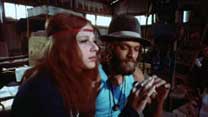
Grindhouse Releasing returns to the digital realm after a long absence – even before the early death of co-founder Sage Stallone – and their limited 3-disc Blu-ray/DVD combo of AN AMERICAN HIPPIE IN ISRAEL is typically stacked with bells and whistles. First up are a series of silent “16mm Screen Tests” (9:10) of the lead actors and several hippie extras. Either the audio is lost or they were more concerned with facial expressiveness since the actors would probably end up post-dubbed. Actors Asher Tzarfati and Shmuel Wolf are on hand for a contemporary Q&A – actually the crosscutting of two separate interviews – in Tel-Aviv (56:04). Wolf – who still speaks in subtitled Hebrew – states that the film is naïve but definitely “anti-capitalist, anti-American, and anti-imperialist” and criticizes the artificiality of the lifestyle. Tzarfati – who responds in English – is not so analytical, and discusses the film as part of the enthusiasm for the emerging industry in the country in the optimistic aftermath of the Six Day War. They both discuss director Sefer, who had started out as a fisherman (but evidently had some acting experience since Wolf vaguely recalls acting with him on stage), and the “pressure cooker” experience of working together as a central quartet of actors for much of the film’s screentime and ten days alone with the small crew on the Coral Island of Eilat. The Q&A and other interviews seem to all date from 2009, and it seems as though fans of the company were wondering for that long or longer when they would get around to releasing it. It’s an interesting talk with two actors who admit to the film’s technical and thematic naiveté but still relish the experience.
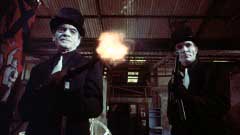
Tzarfati also appears in a video interview titled “An Israeli Actor in Israel” (17:52) – although he was actually born in Greece and brought to Israel as a child (he later studied acting in England) – shot in the same location (and possibly composed of extracts unused in the above Q&A). He describes the best movies as eliciting the feeling of being born, and then discusses his childhood and upbringing in relation to his lifelong love of the movies (and rock ‘n roll) including his admiration for the likes of James Dean, Alan Ladd, and Victor Mature. He also answers questions about working with Golan-Globus, who he admits did not make very good movies but were very enthusiastic and they were the best of Israeli movies of the time. He also discusses some of his more recent work like DOUBLE TEAM with Jean-Claude Van Damme, and almost falling out of a helicopter while shooting RIDING THE EDGE (which was partially filmed in Los Angeles). The discs also include director Amos Sefer’s early silent short 16mm film "Be Careful Children The Ball is Not Just Yours" (6:42) which juxtaposes a children’s party with one featuring adults acting like children and violently fighting over the titular ball which is a world globe (and stock footage of the world cataclysms that have their basis in squabbling). The poorly preserve source is jittery and the original photography is sometimes out of focus and it’s not terribly interesting on its own, but it shows Sefer’s (who also edited AMERICAN HIPPIE) ability to assemble images and crude animation (like the final image in the director’s cut of the feature).

“A Cult is Born” (4:38) features comments from Israeli viewers at a recent screening of the film. Some regard it as a masterpiece, others as “the best bad movie”, and make comments on the film’s stylistic debts to the musical HAIR and to Stanley Kubrick. There is also footage from the screening (with a fully involved audience and an entertainer providing live commentary and singing during the film), and it appears that they have used the Israeli Film Archive print of the director’s cut going by the Hebrew and French subtitles. The “Channel 10 Segment” (10:22) is a 2010 news story on the film’s cult status which asks the question “How bad does something bad have to be, so that we’ll think it’s good?” It features sound-bytes from Wolf and Tzarfati who attended some of the screenings and more comments from viewers, and likens the film’s cult phenomenon to THE ROCKY HORROR PICTURE SHOW and Ed Wood films. Apparently, very few people in Israel knew about the film’s existence and discovered it through Grindhouse Releasing (and then tracked down the director’s cut). The story also includes an interview with the director’s son who unboxes newspaper clippings, rare photographs, and recalls his father’s goals as a filmmaker. Composer Nachum Heiman also appears briefly recalling how Sefer wanted a British pop-influenced score and rejected the effort by Israeli folk singer Shlomo Artzi. The narrating reporter and the news anchor are typically derisive about the film, but the ten minute story itself is well-constructed and more in-depth than anything we would get stateside from local or national news these days.
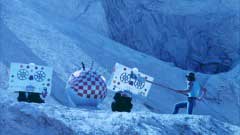 The
Blu-ray and DVD also include contemporary interviews with assistant production
manager Moshe Berman (3:59) and singer/actress Susan Devore (7:07) who along
with her partner Fran Avni peformed the film’s two songs (including an
onscreen performance during the commune scene). Berman’s father-in-law
Yitzchak Shechna owned a pillow factory in the United States. When Shechna immigrated
to Israel, his family hoped that he would invest his proceeds – about
$250,000 in a gas station, but he decided to answer an ad looking for an investor
in a film. Shechna asked his son-in-law to oversee the location filming. As
the prefatory text states, “the results were tragic” since the film
was rejected by the censors; however, Berman is able to recollect it humorously
to the camera now. Devore discusses forming the group with Avni performing songs
by Leonard Cohen and Joni Mitchell, as well as their early notoriety. She recalls
appearing in the film and not getting to see it (her brother was invited to
a screening as a potential investor to provide additional funds to finish it).
The interviewer fills her in on how people receive the film (perhaps playing
up its badness a bit) and is accurate in stating that the audience laughter
during her musical performance stems more from the other visual elements of
the scene (the shots of stone faces and the cameraman’s shadow appearing
at the edge of the frame every so often). The second half of the interview actually
includes Fran Anvi talking with Devore and the interviewer via webcam who talks
about the negative perception of hippies in Israel at the time. The featurette
closes out with Devore’s attendance a screening and performs one of the
songs before the film starts. Her perception of the film seems to have improved
after the screening.
The
Blu-ray and DVD also include contemporary interviews with assistant production
manager Moshe Berman (3:59) and singer/actress Susan Devore (7:07) who along
with her partner Fran Avni peformed the film’s two songs (including an
onscreen performance during the commune scene). Berman’s father-in-law
Yitzchak Shechna owned a pillow factory in the United States. When Shechna immigrated
to Israel, his family hoped that he would invest his proceeds – about
$250,000 in a gas station, but he decided to answer an ad looking for an investor
in a film. Shechna asked his son-in-law to oversee the location filming. As
the prefatory text states, “the results were tragic” since the film
was rejected by the censors; however, Berman is able to recollect it humorously
to the camera now. Devore discusses forming the group with Avni performing songs
by Leonard Cohen and Joni Mitchell, as well as their early notoriety. She recalls
appearing in the film and not getting to see it (her brother was invited to
a screening as a potential investor to provide additional funds to finish it).
The interviewer fills her in on how people receive the film (perhaps playing
up its badness a bit) and is accurate in stating that the audience laughter
during her musical performance stems more from the other visual elements of
the scene (the shots of stone faces and the cameraman’s shadow appearing
at the edge of the frame every so often). The second half of the interview actually
includes Fran Anvi talking with Devore and the interviewer via webcam who talks
about the negative perception of hippies in Israel at the time. The featurette
closes out with Devore’s attendance a screening and performs one of the
songs before the film starts. Her perception of the film seems to have improved
after the screening.
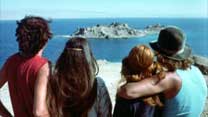 Wolf
displays some of his photographs from the film – which he mentioned during
the Q&A – as well as some rare ad mats in “Shmuel's Still Show”
(4:59), and the disc also includes a gallery of roughly sixty “Production
Stills” and a smaller one of “Promotional Materials” (including
French ad mats, various posters (including Grindhouse ones), Israeli newspaper
clippings, and some photographs from recent US screenings, as well as a filmography
for Tzarfati and biography for Sefer. Besides the film’s theatrical trailer
(3:01), both the Blu-ray and DVD also feature previews of coming attractions,
but the Blu-ray features a couple extra titles (possibly due to space issues
on the DVD). The complete list of trailers are as follows: Robert Hartford-Davis’
CORRUPTION with Peter Cushing, Sergio Sollima’s THE BIG GUNDOWN, THE SWIMMER
with Burt Lancaster, MASSACRE MAFIA STYLE, GONE WITH THE POPE, POOR WHITE TRASH
2, Lucio Fulci’s CAT IN THE BRAIN, I DRINK YOUR BLOOD, Juan Picquer Simon’s
PIECES, DEATH GAME, THE TOUGH ONES, FAMILY ENFORCER, Ruggero Deodato’s
CANNIBAL HOLOCAUST (both the original export and Grindhouse Releasing’s
own re-release trailers), and ICE HOUSE. (Eric
Cotenas)
Wolf
displays some of his photographs from the film – which he mentioned during
the Q&A – as well as some rare ad mats in “Shmuel's Still Show”
(4:59), and the disc also includes a gallery of roughly sixty “Production
Stills” and a smaller one of “Promotional Materials” (including
French ad mats, various posters (including Grindhouse ones), Israeli newspaper
clippings, and some photographs from recent US screenings, as well as a filmography
for Tzarfati and biography for Sefer. Besides the film’s theatrical trailer
(3:01), both the Blu-ray and DVD also feature previews of coming attractions,
but the Blu-ray features a couple extra titles (possibly due to space issues
on the DVD). The complete list of trailers are as follows: Robert Hartford-Davis’
CORRUPTION with Peter Cushing, Sergio Sollima’s THE BIG GUNDOWN, THE SWIMMER
with Burt Lancaster, MASSACRE MAFIA STYLE, GONE WITH THE POPE, POOR WHITE TRASH
2, Lucio Fulci’s CAT IN THE BRAIN, I DRINK YOUR BLOOD, Juan Picquer Simon’s
PIECES, DEATH GAME, THE TOUGH ONES, FAMILY ENFORCER, Ruggero Deodato’s
CANNIBAL HOLOCAUST (both the original export and Grindhouse Releasing’s
own re-release trailers), and ICE HOUSE. (Eric
Cotenas)